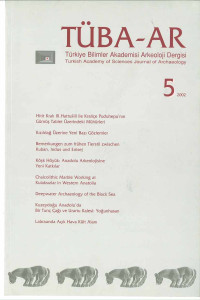Öz
Yoğunhasan fortress is located 42 km of Kars Sarıkamış district, south of the Araxes River, at a junction formed by Caucasus Kars Sarıkamış-Horasan-Hasankale-Erzincan-Sivas route coming from Caucasus and reaching into the heart of Anatolia, and India-Afghanistan-Northwest Iran- Nakhichevan-Iğdır-Kağızman route. There is no other fortress in the region that controls these important routes and bears such a strategic position. The fortress 1930 m above the sea level, rises on a rocky hill of andesite. While the eastern and the northern sides of the fortress are preciptious, the vulnerable western and southern sides are protected by strong defense walls. These terraced walls have no curtains and bastions. The fact that the fortress was strengthened with terrace walls and that the walls were built on the weakest points is a common characteristic of Middle Bronze and Early Iron Age fortresses in East Anatolia and Nakhichevan. A small polychrome pot, found in the illegal digs of the villagers, also proves that the fortress witnessed habitation beginning from the Middle Bronze Age.
Yoğunhasan fortress gained its actual importance during Menua's military expeditions to the Land of Diauehi. In the Urartian period the fortress served as a very important military headquar ters and production center. Scholars located the Land of Diauehi in different geographical regions according to the phonetic similarity of the toponyms or modern physical maps. Our localization of the Land of Diauehi, on the other hand, depends on the evaluation of the data from our surveys carried out in the region for years. According to those data, the Land of Diauehi stretched from the north of Araxes and the east of Horasan district to the Sankams and Kars regions.
A rock tomb with a main hall and two rooms exist at the steep eastern part of the Yoğunhasan fortress. The culvert above the entrance door, the moulding on the walls of the vaulted main hall as well as the rooms themselves represent a typical miniature of the rock tomb of Menua in the Inner Fortress on the southern face of the Urartian capital Tushpa. The monumental appearance of the rock tomb and its elaborate workmanship suggest that it belongs to a ruler. This type of rock-cut tomb is the oldest and the most monumental tomb form in the Near East. We named the arti ficial lake, which is 300-400 m southwest of the fortress as Yogunhasan Lake. The wall of the lake blocks the northeastem section. There is still plenty of water in the lake, though, more than two thirds of the wall has collapsed. The artificial lake still functions; the water, directed to the north, has been supplying the orchards for 2800 years.
Anahtar Kelimeler
Yogunhasan Kalesi Orta Tunç Çağı boyalı çömlek Urartu Krallığı Diauehi kaya mezarı Yoğunhasan Göleti
Kaynakça
- BARNETT, R.D., 1952 "Urartu". Cambridge Ancient History 3/2, 314-371.
Öz
Anahtar Kelimeler
Yogunhasan Fortrose Middie Bronze Age polychrome ware Urartian Kingdom Land of Daueh rock tomb Yogunhasan Lake
Kaynakça
- BARNETT, R.D., 1952 "Urartu". Cambridge Ancient History 3/2, 314-371.
Ayrıntılar
| Birincil Dil | Türkçe |
|---|---|
| Konular | Erken Tunç Çağ Arkeolojisi, Arkeoloji (Diğer) |
| Bölüm | Araştırma Makaleleri |
| Yazarlar | |
| Yayımlanma Tarihi | 15 Aralık 2002 |
| Gönderilme Tarihi | 15 Haziran 2002 |
| Yayımlandığı Sayı | Yıl 2002 Sayı: 5 |
Kaynak Göster
Bu sistemin içeriği ve TÜBA-AR'da yayınlanan tüm makaleler "Creative Commons Attribution-NonCommercial-NoDerivatives 4.0" altında lisanslanmıştır.


